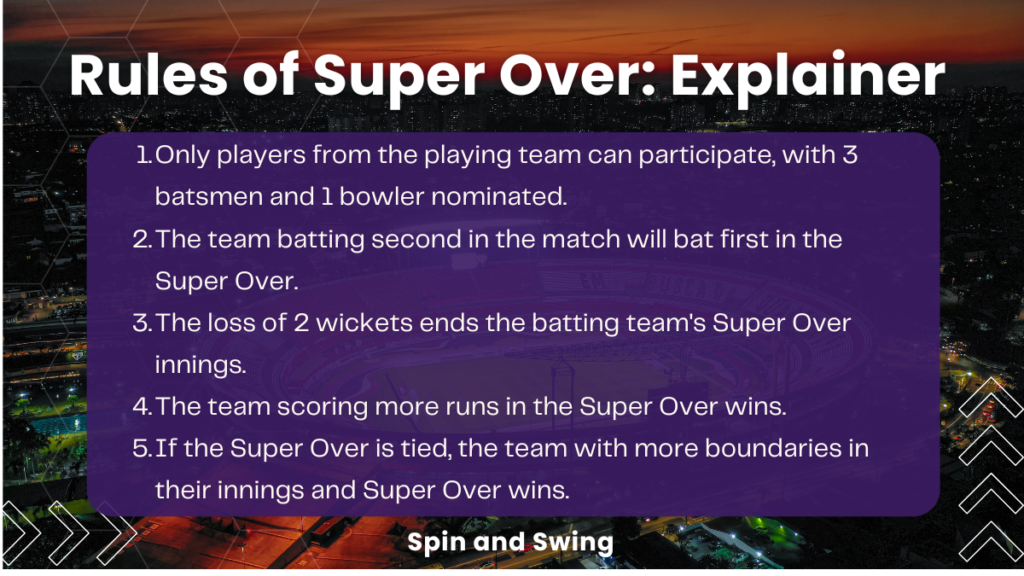What is a Super Over? In the cricket world it’s rare to find something so thrilling as a cricket match which ends in a tie which is why the Super Over comes in. It’s a specific tiebreaker for choosing the winner in limited-overs format in which both teams hit the same number of runs. The rule of super over gives an added level of excitement by giving teams an extra over in which to score the most runs they can.
History of the Super Over: What is a Super Over?

The history of super over rules in cricket can be traced back to 2008, when it was first introduced during the Indian Premier League (IPL). Before that, tied matches often resulted in shared points or a bowl-out, a less exciting method. The introduction of the super over rules changed that, bringing a fair yet exciting way to decide tied matches.
This concept gained global attention during the 2019 ICC Cricket World Cup final, widely regarded as one of the best super overs in cricket history. England and New Zealand fought hard, winning a tie even after the super over. The winner was determined by the boundary count rule, a controversial decision that has since sparked debates about fairness and led to changes in the cricket super over rules.
The Rule of Super Over

So, what exactly happens in a super over? Let’s break it into simple steps:
Teams Bat for One Over:
- Teams Bat for One Over: Each team gets six balls (one over) to score as many runs as possible. The team that scores more in their super over wins.
- Limited Wickets: Each team can lose only two wickets in the super over. If two batters are dismissed, the over ends even if balls are left to bowl.
- Same Batting Order Doesn’t Apply: Teams can choose any three batters and one bowler for the super over. They aren’t bound by the batting or bowling order from the main game.
- Tied Super Over: Rules vary depending on the tournament if the super over is also tied. For example, earlier tournaments relied on boundary counts, but newer regulations may involve multiple super overs to break the tie.
- Bowler Restrictions: A bowler who delivers the super over cannot bowl consecutive super overs if the match requires another tiebreaker.
Super Over in Different Formats
The rule of super over differs slightly across formats and tournaments:
IPL Super Over Rules:
- Tiebreaker: If an IPL match ends in a tie, a Super Over decides the winner.
- Bowler Restrictions: The bowler for the Super Over can be anyone from the team, but they cannot bowl consecutive Super Overs if another Super Over is needed.
- Tied Super Over: If the Super Over ends in a tie, another Super Over is played. This process continues until a winner is determined.
International Cricket Super Over Rules:
- Tiebreaker: The ICC uses a Super Over to decide tied matches in international cricket.
- Previous Rules: Earlier, if the Super Over ended in a tie, the winner was determined by the number of boundaries scored in the entire match (including the Super Over). This controversial rule, especially after the 2019 ICC Cricket World Cup final, led to debates.
- Current Rules: The ICC has updated the rules, and additional Super Overs are now played until a winner is decided. The boundary count rule is no longer in use.
Memorable Super Overs in Cricket History
Some of the best super overs in cricket history have left fans speechless. The 2019 ICC World Cup Final stands out for its intensity and controversy. Another remarkable moment was during the 2020 IPL match between Kings XI Punjab and Mumbai Indians, where two consecutive super overs decided the game.
The highest runs in super over were scored during the 2021 Big Bash League when Melbourne Stars smashed 23 runs, setting a record. Such moments highlight the unpredictability and excitement that the rule of super over brings to cricket.
Why the Super Over Matters
The cricket super over rules has transformed the way fans experience tied matches. Instead of disappointing results, they now witness a thrilling showdown. This tiebreaker tests players’ skills, calmness under pressure, and plans.
For batters, hitting boundaries becomes critical, while bowlers aim for dot balls and crucial wickets. The team’s plan to start with full energy or keep some strength for the final balls can decide the outcome.
Evolving Super Over Rules
With every tournament, the super over rules continue to evolve. For instance, the boundary count rule from the 2019 World Cup was criticized and later replaced with more practical measures. These changes ensure fairness and adapt the format to modern cricket’s fast-paced environment.
Conclusion
So, what is a super over? It’s more than just a tiebreaker—it’s a stage for cricket’s most surprising and intense moments. The rule of super over has given fans some unforgettable memories and redefined how tied matches are resolved. Whether it’s about the history of super over rules in cricket or the strategies employed, this concept keeps the spirit of competition alive.
From record-breaking runs in a Super Over to unforgettable moments in cricket history, these instances showcase the true spirit of the game. As the format keeps evolving, it guarantees even more excitement and memorable experiences for players and fans. For more updates on cricket, including the latest IPL information, match analyses, player insights, and engaging cricket blogs, visit our website, Spin and Swing.
FAQs
What is a super over in cricket?
A super over is a tiebreaker where each team bats for six balls to decide the winner of a tied match.
What are the cricket super over rules for wickets?
Teams can lose only two wickets in a super over; the over ends if two batters are dismissed.
What is the history of super over rules in cricket?
The super over was introduced in 2008 to replace the bowl-out method for resolving ties.
What happens if the super over is tied?
If a super over is tied, additional super overs may be played depending on the tournament rules.
Who can bat and bowl in a super over?
Teams can choose any three batters and one bowler regardless of the main game’s order.



